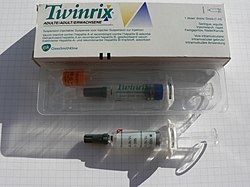 Combined hepatitis A and B vaccine (Twinrix) | |
| Combination of | |
|---|---|
| Hepatitis A vaccine | Vaccine |
| Hepatitis B vaccine | Vaccine |
| Clinical data | |
| Trade names | Twinrix, Ambirix, others |
| AHFS/Drugs.com | FDA Professional Drug Information |
| License data | |
| Pregnancy category |
|
| Routes of administration | Intramuscular |
| ATC code | |
| Legal status | |
| Legal status | |
| Identifiers | |
| CAS Number | |
| ChemSpider |
|
| UNII | |
Combined hepatitis A and B vaccine, is used to provide protection against hepatitis A and hepatitis B. [3] [7] It is given by injection into muscle. [8]
Contents
It is used in areas where hepatitis A and B are endemic, for travelers, people with hepatitis C or chronic liver disease, and those at high risk of sexually transmitted diseases. [7]
The combined vaccine is as safe and protective as if given as separate hepatitis A and B vaccines. [7] It is generally well-tolerated. [9] Common side effects are mild and include redness and pain at the injection site, where a small lump may appear. [8] Feeling faint or tired, or a headache may occur. [8] Other side effects include numbness, tingling, rash, bruising, abnormal bleeding such as from the nose or gums, weak muscle or pain. [8] Severe side effects are rare and include an allergic reaction and seizures. [8]
It is widely available. [7]